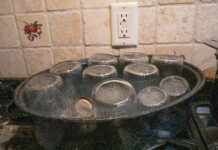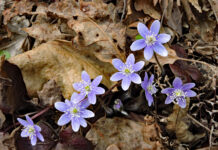
We think of the plains states as Wyoming, Kansas and others out west; places where buffalo roam and the deer and the antelope play, according to the old song. However, few people realize that there were plains in what is now Ohio.
Granted they were small and scattered, mostly in the west and northwest, making up only 1% of what is now the state’s acreage. But historians agree they were spectacular, teeming with wildlife, wildflowers and grasses that grew “to a height sufficient to hide man and horse.”
That made Ohio the eastern edge of the tall grass prairies. But by the time those prairies were settled, drained and cleared for farming in the 1800s, perhaps only 1% of the original 1% of the acreage was left.
“A half acre here, a few tenths there,” is how Richard Gardner, chief botanist for the Ohio Department of Natural Resources’ Division of Natural Areas and Preserves, describes it. Most of those patches were along roads or railways, banks of streams, or in cemeteries that contain graves of the first settlers, he said.
The good news is that what remains of many of the former plains areas are under the protection of his agency. One example is the Sandusky Plains, which used to cover more than 200,000 acres south and west of the Sandusky River. Now there are only 74 acres left, most in the Daughmer Prairie Savannah State Nature Preserve.
There, visitors can hike a 1-mile trail to see the wildflowers and wetlands, as well as towering bur oaks that are more than 200 years old. It is named for five generations of the Daughmer family who maintained the prairie habitat through low-intensity grazing and periodic controlled burns, which the agency continues to do today.
But there is one place where visitors can glimpse “a sea of wild grass, and flowering herbs,” as one pioneer described what are now called the Darby Plains, in the Big Darby Creek watershed west of Columbus.
Many of those plains areas are designated as natural preserves but are also part of the Battelle Darby Creek Metro Park. Since the 1970s, nearly 3,000 acres of the Darby Plains have been restored to their original glory, using grass and wildflower seeds from those tiny patches of the original plains.
There are even bison — the correct name for buffalo — thanks to a partnership between the park, the Columbus Zoo and The Wilds that includes a breeding program. Four calves were born within the park’s enclosures last spring.
“It’s a really cool story,” said Elaine Hall, assistant resource manager for the park, part of the Columbus and Franklin County Metropolitan Park District. “Bison are grazing on plants they would have grazed on hundreds of years ago.”

History
In those days, the plains were wet most of the year but dry in summer. Lightning strikes often sparked wildfires, but the Native Americans also did their own versions of controlled burns “to help with hunting and just being able to walk through those areas,” Gardner said.
He said the fires helped the tall grasses, most of which grew 8 to 10 feet tall and had beautiful blooms at the top. They included prairie dock, compass plant, switchgrass and prairie cordgrass, which has sharp blades that discourage grazing. The settlers called it gut-slashing grass because it could cut the stomachs of horses that galloped through it.
The fires maintained the grasslands by putting nutrients and seeds back into the rich, black soil and reducing woody growth, he said. One exception to the latter was the bur oak. It has a thick bark that is fire resistant, explaining the centuries-old oaks in the Sandusky Plains and elsewhere.
The Native Americans’ care of the land ended with the Treaty of Greenville in 1795. An alliance of mostly Algonquin-speaking tribes continued to resist settlement by Europeans after the Revolutionary War. Surprisingly, they defeated U.S. troops in their campaigns of 1791 and 1792, bringing settlement of the Northwest Territory to a halt. That is until President Washington put General “Mad” Anthony Wayne in charge of the military and ordered him to crush the resistance. The tribes suffered defeat in the Battle of Fallen Timbers, south of what is now Toledo, in 1794.
The British, who still had forts in the area and had promised to help the tribal alliance, abandoned them as well as their forts later that same year. So the alliance headed by Chief Little Turtle signed the Greenville Treaty giving up their land in what is now Ohio, plus large portions in Indiana, Illinois and Michigan.
“When the Native Americans stopped the controlled burns, the grass became overgrown and the mosquitoes got really bad,” Gardner said.
The first settlers called the flat, wet plains “the barrens” and many died of malaria carried by the mosquitoes. According to “The History of Madison County,” published in 1883, they built cabins along the streams where land was elevated and drier, and where the best timber grew.
Still, they recognized that the tall grasses were nutritious for their livestock. They cut them in June and July and fed them all winter. The grasslands were also home to an abundance of wild game that they could hunt for food.
They found other ways to use the tall grass. For instance, they discovered prairie dock, with its yellow blossoms at the top, oozed a sticky substance when cut. This became chewing gum for the youngsters.
Though there were no more controlled burns — at least none that weren’t disastrous — there were still fires from lightning strikes. The settlers would often burn a ring of grass 20 or 30 feet wide around their cabins to protect hay and homes.
They also recognized that the rich soil would be wonderful for agriculture, but they would have to drain the prairies and wetlands. Ditches began to appear and the state legislature passed drainage laws, the history book says.
Looking ahead
The Big Darby and Little Darby creeks are designated state and national scenic rivers. In 1991, The Nature Conservancy declared the creeks and their watershed to be one of the “12 Last Great Places of the Western Hemisphere” that need saving.
But the people who formed the park district in 1945 were way ahead of them, especially since the city of Columbus was growing so rapidly. They wanted to save the watershed and the remnants of the plains, so they began purchasing land. The Battelle Darby park now covers 8,000 acres while the Prairie Oaks Metro Park to the north, which also includes some of the historic Darby Plains, covers nearly 3,000 acres.
In the mid-1970s, science teacher and park prairie specialist Jack McDowell started using the Darby Plains remnants to restore prairie environments. With buckets hung around his belt and a team of volunteers, he collected seeds of forbs (wildflowers) and grasses from the Bigelow Pioneer Cemetery and those little patches along roadways and creek banks, planting them elsewhere on parkland. McDowell died in 2012 and now has a restored prairie named for him.
“We still continue Jack’s work today,” Hall said, although now seeds from restored prairies are used to create even more. Forb seeds are still picked by hand, each kind kept separate in the park’s seed room. The only difference is that prairie grass seeds are now harvested by combines, which “creates a bigger bulk for restoration,” she said.
Hall says the restored prairies aren’t just attracting people. Coyotes, muskrats and deer have taken up residence, while tiger salamanders love the vernal pools that appear in spring. Butterflies and other pollinators are piling in.
The wet prairies in the park are considered one of the birding hot spots in Ohio based on the number of species recorded there on the eBird app, she said. American bitterns and Sandhill cranes are spotted regularly, while three wood storks — a species not normally seen in Ohio — appeared in plains areas this summer, perhaps pushed north by the hurricanes.
“These vast, open spaces offer different natural phenomena in each season,” Hall said. “There is no bad time to visit the prairies.”










